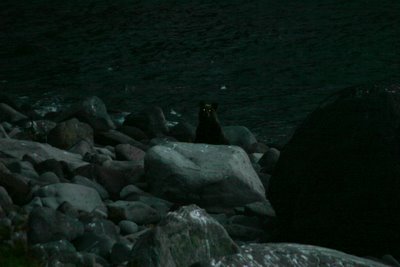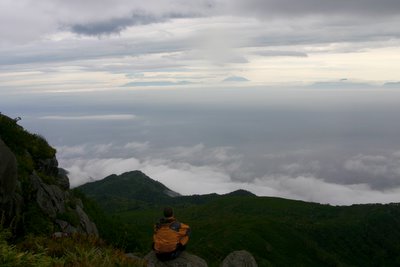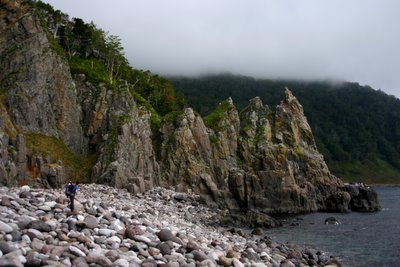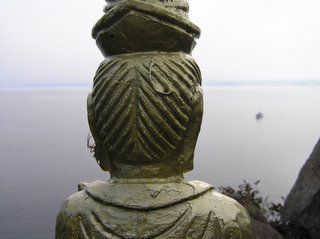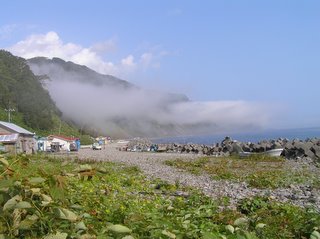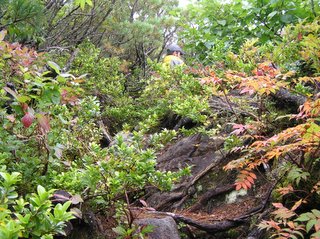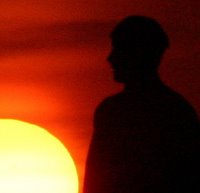A continuation of the previous post..
Having biked up and down the same street in this small town every day for over a year, the excitement of living in Hokkaido has faded away. In new places, during the Honeymoon stage of cultural adjustment, surfaces alone are fascinating - the landscape, the buildings, the people - when I first arrived last year, even riding past the vending machines at the bottom of my driveway was enough to send a little shiver up my spine. That feeling is gone now, for the most part. A place can only be exotic for so long, especially a former coal mining town of 5,000 people after a winter that stretches into the middle of May. I'm looking forward to moving on, continually refreshing my surroundings, embracing movement, because just being somewhere for the first time is the best sort of entertainment. When traveling, adventure is only as far as the next street corner.
Of course, as I've written before, exploration is more a matter of mindset than geography. Wading down a stream with no flashlight in the middle of the night and hoping that it would lead me to civilization before dawn was more of an adventure than hanging out in the Pizza Hut at the base of the pyramids, even though the stream was only a two hour bushwhack from my house. Finding adventure is often as simple as looking for it.
Biking home through town last Monday was not an adventure. The things I saw were interesting not because they were new, or exotic, but because I know them, because I have come to understand the connections between people and places, the underlying context of life in Utashinai. Living in a place long enough to cultivate this kind of awareness is the opposite of extended travel, but, riding home, I wondered if paying attention long enough to appreciate the details was no less rewarding than simply refreshing a broader perspective over and over. Could travel - the act of movement - be a lazy way of interacting with the world, counter-intuitive as that might seem?
And then I was home, with three hours of daylight and no pressing chore. Back out the door, back down the driveway and up the dirt road toward the coal fields, confident that something would come along, some moment new, or beautiful, or somehow worthwhile. The same rows of old wooden homes, some occupied, most empty. The same red apartment block, big white radishes hanging off balconies to dry. The same garden, the same stream. I stopped halfway up the road and watched the same old woman puttering around in her garden, so lonely and so old, bundled up in scarfs and sweaters with her loose-framed little house catching the cold October light. A fox howled somewhere up on the ridge. There's the moment, I thought. That's what you came out walking for.
The road dead ended soon at, the same overgrown meadow and the wooden house, much like the old woman's, except this one abandoned and collapsed under last winter's snow. I've poked around here before - but this time I walk gingerly over what was once the roof, brushing past weeds and stepping carefully down into the living room. There is a pile of books in one corner, spilling out of a soggy cardboard box, pages stuck together and mildew spreading down the spines. Some comics, old textbooks, a junior high-school notebook that might be interesting if I could read Japanese.
Another stack of books, on the other side of a collapsed wall. Rusty nails poke out through the boards, and I wonder if it's worth it to pick my way across and check them out. But of course I do, testing my weight on each board, holding onto what was once a windowsill....and wow I'm glad I did, because check it out - that's English! "The Silent Language," says the cover, which tears off when I gingerly pick it up. Little bugs crawl out from the binding - the whole thing is soaked through, and I can't turn the pages. They come unstuck where they want to - on page 86 - where the author, an American anthropologist who worked in the Pacific during World War II, is explaining how a major barrier to understanding a new culture is that nothing is spelled out for the newcomer - over the years, a context develops, so that locals, aware of the connections between people, places and events, feel no need to talk about them. The Silent Language. Exactly what I had been thinking about during the bike ride home.
There was still some light. I tossed the book back on the pile and lumbered off into the brush, pulling myself up the ridge by grabbing a hold of sturdy bamboo grass, coming out twenty minutes later near the coal pits. From up there I could see over the valley wall to where the sun was setting. After a few minutes I heard a truck rumbling near, so I stuck out my thumb and hitched a ride back down to the valley. The driver was from Utashinai, and I'm sure he thought he had seen it all. I was glad that I could be there to pop out of the woods - white face and raggedy jeans - bringing just a little uncertainty to a road he had hauled coal down for years.

